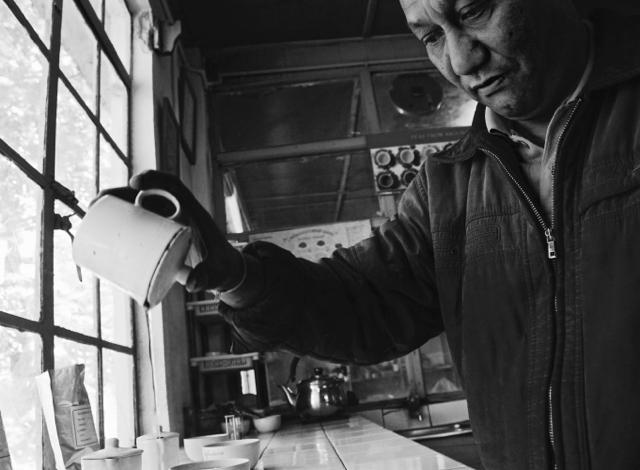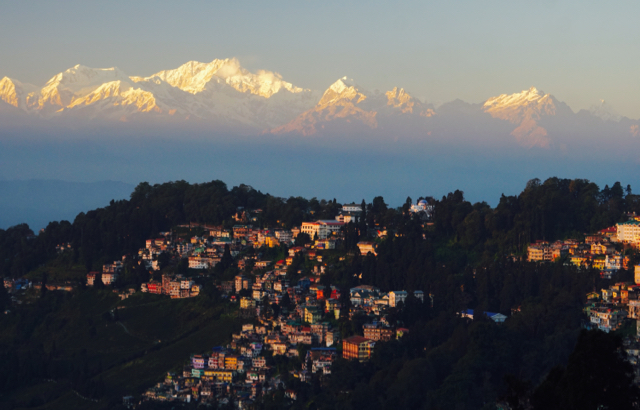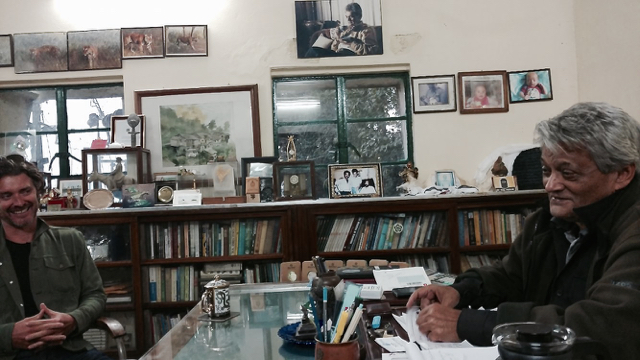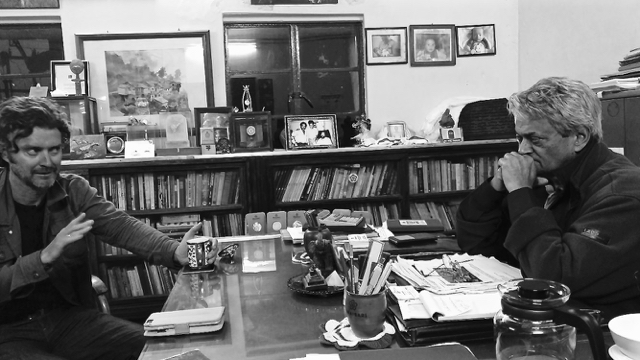A joy is sometimes not having a huge frame of reference nor expectation. There are no cues, limited preconceptions, and there is that wonderful feeling of slight ignorance. It is in this ‘not knowing’ that there is some room to simply listen, observe, and take it all in. ‘Easy to please’ could be one way of looking at it, but I much prefer the attitude that at times the senses know far better than the intellect. What hits the senses can mesmerize if there if there are fewer references.
My own experiences with Darjeeling’s have over the years been slightly suspect, except for a few rampantly good teas that one would be hard-pressed not to enjoy. A Jungpana comes to mind and a particular Makaibari given by friends in minute quantities. Both rattled the palate and hinted that there was far more to explore in the machine made teas of the acclaimed mountainous zone of Darjeeling. Never have Darjeeling’s been vital enough in my day to day sip-sessions that I’ve spent much time with them.
My head and palate have been filled with the hand-crafted teas (at times awful) that had in them a kind of signature or one-off feel. These small yield hand-crafted offerings that had a story and an explanation beyond simply a bulk offering…but of course in thinking this, it was bound to change.
The world of Puerhs and Taiwan’s Wulongs have inundated my life for years and Wulongs were my first luscious experiences. Complex, ridiculous, and often created in batches that would scarcely fill a satchel, they were the special bits of someone’s efforts that I strove to find. The palate has learned what it likes in those realms and living in Yunnan has been a great instruction in Puerhs in particular. There is hype, mystique, ferociously bad teas, and there are wonderful classics, which swim around under the surface. These teas that were difficult to find and that added to their allure.
Times change, the intellect changes, and the palate sometimes requires an abrupt ‘re-introduction’ to something to re-charge and re-calibrate the head, blood, and palate. Recently, have completed an expedition to the stunning Himalayan Ice Towers, and glaciers of Gangotri in Uttarakhand, there was time (plenty of it) to stop in Darjeeling and finally – over the course of weeks -unhinge a little with as many cups as I could find. No better or more tangible way exists to immerse into tea than to simply immerse in the space and people that produce the leaves. Not about criticizing or ripping apart teas by impression, this was to be an informal instruction and conversation with each and every cup. An immersion into a region where the precious offering is common rather than rare, where it is breathed in and consumed in heaps, rather than hidden away and treated as a treasure. An irony with Darjeelings, is that most of the Indians I’ve met do not actually consume Darjeeling, preferring instead the headier and provocative spices and sweetness of prepared masala chai, a stiff Assam or fragrant Nilgiri.
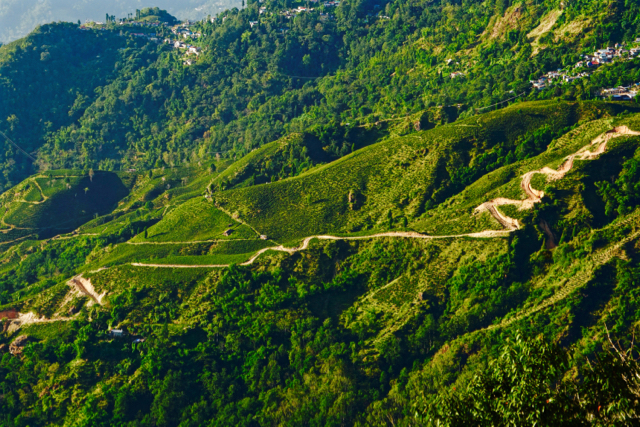
Lands that bleed green. No shade cover or at least minimal compared to much that I’m used to in Yunnan and Taiwan.
Darjeeling’s legacy has always been one of finding its way into long-distant ceramic cups across oceans and seas, across borders and through various ports. Now I’m here at the fringe of Himalayas, between the dusty hills and the enormous clear skied heights. Year’s ago, I had raced through the region sipping ravenously on the way to track down the remnants of the Tea Horse Road in Gangtok, Sikkim. At that point in life, teas were offerings and a kind of air to breath.
This return was to come and sip and learn and chat.

My wife Julie gets into the action at a roadside restaurant where the leaves were flowing everywhere
A series of tea gardens were on the wish-list, and a series of teas to consume. Formal tastings are vital but so too are the discussions with the makers and managers in their spaces, in their fields, in their seats. Of equal importance is to be able to sip the teas alone without any hype or words, first thing in the morning. Since ‘home’ would be tea estate bedrooms and little hotels, it was then vital to have the necessaries: a kettle, good water, and a ceramic tea pot serving vessel ….and that gorgeous luxury of time to take tea whenever I could. Over-steeping it, under-steeping it, steeping it twice….to do it all.
Not a good way to start anywhere, by being late….but here I am at the legendary Makaibari tea estate and I was entirely late (and admonished). Sitting with the provocative and philosophical and mildly outrageous Makaibari tea estate owner, “Raj”, as he is called, Rajah Banerjee there is bound to be tea and provocation. Owner and brilliant pusher of the first major biodynamic tea farms, Raj prefers speaking about people and culture – and Rudolf Steiner’s views of all things – than getting too much into tea…at least at the beginning. In 2014 he sold off much of Makaibari and the world’s first factory, but he remains very much the irrepressible and controversial spirit of Makaibari. He is in many ways like a beautifully preened rock star who prefers to speak about bigger concepts than simply his teas which have become such sumptuous treats the world over.
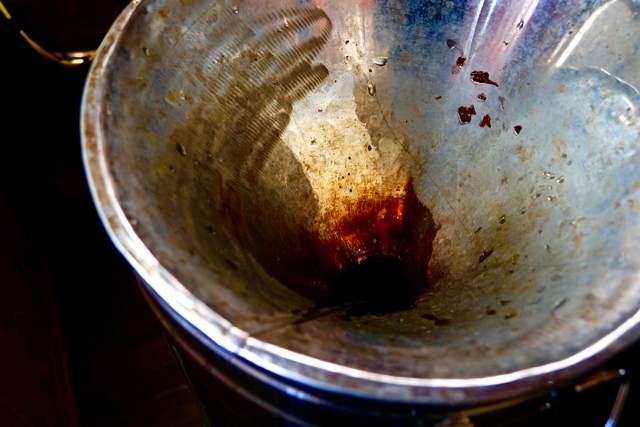
Darjeeling is not simply about cups….here a spittoon for discriminating drinkers and samplers slurp in ounces, only to get rid of much of it.
The tea he serves us is luscious and even more luscious are his conversations about earthworms, space and time, and poaching. Provocative, utterly irreverent in many things, the present overseer of Makaibari is imbued with charisma…ironically the softest tones he speaks in are about tea. Hated by some, copied by many, and a curious piece of showman to almost all, Raj sips back tea in fast-flowing litres. He knows his tea and he drinks his teas, and speaks not as a salesman but as a ‘needer’ and believer in the leaf….the way it should be.
Sitting with him and his ancient photos, artifacts, and bits and bobs of a life spent hosting guests from every point of the globe, it feels as if decades of experiences and folks are imbued in the place and in the man who sits elegantly folded behind a cluttered desk.
We sip a summer harvest which has been made to a strength that verges on being gnarly, but doesn’t quite make it there. A second cup and I’m convinced it should be only served at such a strength. Such is what a maker of great cups can do, and the maker is a beautifully clad woman who wafts around outside Raj’s office. Night cramps in and the plumes of dust and airborne sediment disappear. Raj tells of the days of tigers, of mystics and proudly, when he was the first of the big gardens to push bio-dynamic organic tea. Pride is etched in his face but only briefly as he issues a gentle command for switch-up in the kind of tea we are consuming…it flows in rather than arrives.
With me is Rajiv Lochan who has conversations with Raj raging in silky English with the odd peppering of glorious Hindi. Having known eachother for long long years, their discussions are a series of questions, some answers and the odd wonderfully coated slights directed at eachother. Raj tends to spend much time shaking his head, while Rajiv enjoys provocation resting his hands upon his belly. Rajiv asks about the tea I drink, and I simply nod and smile saying something glorious about those who know not simply the tea, but the method of preparing a great cup. More to follow as Jungpana and Goomtee Estates loom…

